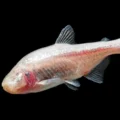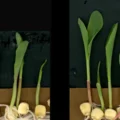Bioluminescence is the natural chemical process of light creation in some living creatures that makes fireflies flicker and some jellyfish glow. Scientists have long been interested in borrowing the secrets of these animals’ light-producing genes to create similar effects in vertebrates, for a variety of biomedical applications.
UC Santa Cruz Assistant Professor of Biomolecular Engineering Andy Yeh is designing completely artificial proteins that produce bioluminescence to serve as a non-invasive method for bioimaging, diagnostics, drug discovery, and more. A new paper published in the flagship journal Chem reports on a new series of bioluminescent proteins designed by Yeh and his group, which are small, efficient, highly stable, and can produce multiple colors of light for real-time imaging in cellular and animal models.
This field of designing proteins that are not found in nature, called “de novo protein design,” recently won a group of scientists the 2024 Nobel Prize in Chemistry, including David Baker, Yeh’s post-doctoral advisor. The proteins described in this paper were created using deep learning protein design softwares developed by Baker’s group, as well as protein structure prediction methods produced by DeepMind, whose founder also shared the Nobel Prize.
“We call this de novo protein design, because these proteins are computationally designed from scratch — it’s not found in nature and not even in the evolutionary trajectory. We demonstrated the use of the recently awarded Nobel Prize concept to build up new light-emitting enzymes, which serve as optical-based probes for biological studies,” Yeh said.
Better imaging probes beyond fluorescence
Many researchers and clinicians use fluorescence imaging techniques to understand disease, aid in drug discovery, and more. Fluorescence probes require external excitation light to shine. When external light shines on a tissue, every cell responds, creating a lot of background light that makes it harder to distinguish whatever the researcher or clinician is looking for.
Bioluminescent imaging is different in that it is “excitation-free” — the whole light emission process occurs on a chemical reaction level. Bioluminescence creates no background light response, making it much more effective for imaging features that may be deep within a tissue, like a tumor.
This paper shows that the researchers’ light-emitting proteins work at the level of molecules, cells, and in a whole animal, making it more generalizable for different kinds of scientific research. It is especially suitable for non-invasive in vivo imaging because it can reveal information about biological processes deep within a tissue in real time without having to remove a sample from the body.
Visualizing multiple biological events
These specially designed proteins are “orthogonal,” with their reaction center highly tailored to the shape of the designed light-emitting molecule. This means that the designer enzyme does not react with other similar molecules that a researcher or clinician may be using at the same time.
“The designed reaction is very specific, so it can be used in combination with existing light-emitting enzymes, because the enzyme recognizes a different molecule,” Yeh said. “People already use light-emitting enzymes found in nature for a lot of biological research, and we are not reinventing the wheel. We are creating additional toolkits that work better and can be used in combination with the bioluminescence tools that the scientific community is familiar with.”
Yeh and his team also developed a method to shift the color of the light emitted by the proteins. Typically, these enzymes shine blue light, but through an efficient energy transfer process, the researchers made it possible to emit green, yellow, orange, and red light. This would allow a researcher or clinician to monitor various different biological features, called “multiplexing,” which is important for studying complex processes such as cancer development.
The new age of de novo protein design
De novo proteins are highly thermostable, meaning that they will not unfold at high temperatures, unlike other naturally occurring bioluminescent enzymes. A highly stable protein would be much easier to use for point-of-care diagnostics, as it would reduce the need for specialized shipping at low temperatures.
“We have now produced light-emitting enzymes with ideal protein folding that nature does not always need to optimize during evolution,” Yeh said. “This is the first instance in which we demonstrated that artificial light-emitting enzymes can produce enough photons in vertebrate animals for bioimaging. The computational protein design methods are becoming better and better, and so will the enzymes we design. I believe it is very true what David Baker said: this is just the beginning of de novo protein design.”









No Comments
Leave a comment Cancel